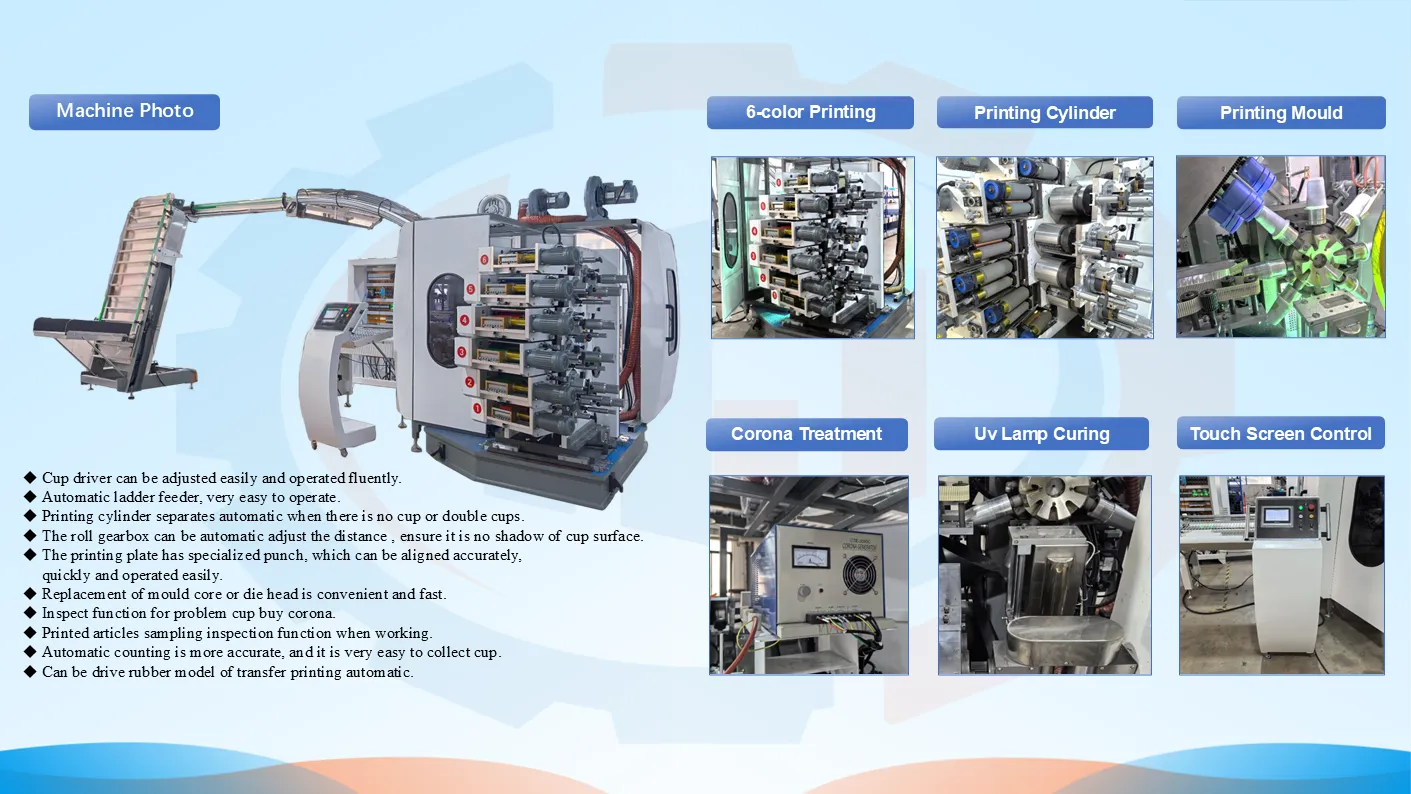
he plastic cup printing machine is a specialized equipment used to print patterns, logos, text, and other content on the surface of plastic cups. It utilizes advanced printing technology to achieve high-precision and high-quality printing on plastic cups of various shapes and sizes. It is widely used in industries such as food packaging, beverages, and catering.
Specialized Printing Equipment for Disposable Plastic Cups
The core challenge of this highly specialized printing equipment lies in achieving high-quality multi-color pattern printing on the conical, non-absorbent plastic surface.
I. Work Introduction (Workflow)
The workflow of a fully automatic offset printing machine can be summarized into the following core steps:
Automatic Feeding
Workers place stacked plastic cups into the hopper of the equipment.
Through an automatic separation device (like a starwheel), the cups are separated one by one in an orderly manner and conveyed to cup holders on the transmission chain or conveyor belt.
Pre-Printing Treatment (Crucial) - Corona Treatment
Plastic cups (especially PP material) have low surface energy and are inert, making ink adhesion difficult.
Before printing, the cups pass through a corona treatment device. This device uses high-voltage discharge to alter the molecular structure of the plastic cup surface, increasing surface energy and roughness, thereby significantly improving ink adhesion and preventing printed patterns from peeling.
Positioning and Conveying
The cups are precisely positioned on servo motor-driven cup holders.
Each cup holder can rotate during conveyance. This is the key to achieving uniform printing on the conical surface.
Printing
This is the core ink. When the cups intermittently pass each printing unit with the transmission chain:
Ink delivery system: Takes ink from the ink fountain and, through a series of ink rollers (ductor roller, vibrating roller, distributor roller), evens out the ink and delivers it to the plate cylinder.
Inking: Even ink is applied to the image areas of the printing plate (relief or resin plate).
First transfer - Plate to Blanket: The plate cylinder contacts the blanket cylinder, transferring the ink from the plate's image areas onto the elastic rubber blanket.
Second transfer - Blanket to Cup: The blanket cylinder, carrying the ink, presses down onto the surface of the rotating plastic cup. Due to the elasticity of the blanket, it conforms well to the conical cup surface, completely transferring the pattern.
Each printing unit is responsible for one color. A machine with 4 units performs 4-color printing; 6 units perform 6-color printing. All colors are overprinted sequentially in a single pass,Ultimately forming the complete color pattern.
Drying and Curing
Plastic is non-absorbent, so the printed ink cannot dry quickly through penetration like on paper.
After printing, the cups immediately enter a UV curing system. High-intensity UV (ultraviolet) light irradiation instantly causes the photosensitive resin components in the UV ink to polymerize, solidifying the ink from liquid to solid within fractions of a second, firmly adhering it to the cup. This process is fast, involves no volatiles, and is environmentally friendly.
Automatic Collection
The cured cups are conveyed to the collection section.
Through mechanical hands or chutes, the cups are re-stacked for worker packaging or directly connected to the next production process (like sleeving, boxing).
II. Working Principle
Its core working principle is offset letterpress printing, also known as indirect relief printing. It combines the characteristics of relief printing and offset printing.
1. Characteristics of Relief Printing:
The printing plate used is a relief plate (typically a flexible resin plate), characterized by the image areas (the parts to be printed) being raised, and the non-image areas being recessed.
During inking, the ink rollers only contact the raised image areas, so ink is only applied there.
2. Characteristics of Offset Printing:
"Offset" means "indirect." It does not transfer ink directly from the plate to the substrate (cup). Instead, it first transfers to an intermediate carrier—the blanket cylinder—which then transfers it to the cup.
Why this extra step?
Adaptability: The soft, elastic blanket can perfectly conform to conical, irregular, or uneven cup surfaces, which a hard plate cylinder cannot do directly.
Quality: Indirect transfer can produce a softer, more even ink layer than direct printing, reducing flaws caused by "hard contact."
3. The Secret to Conical Surface Printing: Synchronized Rotation
To correctly print a flat pattern onto a conical surface without distortion requires precise synchronous movement.
The machine's cup holders precisely grip the cups and cause them to rotate at a specific speed.
This rotation must be strictly synchronized with the circumferential linear speed of the blanket cylinder. Through precise mechanical or servo electronic control, it is ensured that the linear speed of the point on the cup surface contacted by any point on the blanket matches that of the blanket. This accurately "wraps" the flat pattern onto the conical surface, preventing pattern stretching, compression, or overlapping.
Summary and Core Advantages
| Feature | Description | Advantage |
|---|---|---|
| Printing Method | Offset Letterpress (Indirect Printing) | Combines the clarity of relief printing with the adaptability of offset printing, suitable for irregular surfaces. |
| Substrate | Conical Plastic Cups (PP, PS, PET, etc.) | Specifically designed for soft plastic containers. |
| Drying Method | UV Instant Curing | Environmentally friendly, efficient, no solvent volatilization, strong ink adhesion. |
| Color Registration | Multi-color units, completed in one pass | High production efficiency, accurate color registration. |
| Automation Level | Fully automatic (auto feeding, printing, curing, collecting) | Low labor requirement, stable production, suitable for large-volume orders. |
In summary, the disposable plastic cup offset printing machine solves the industrial challenge of high-quality color printing on conical plastic cups through the ingenious design and coordination of relief platemaking, offset transfer, conical surface synchronization, and UV curing.


